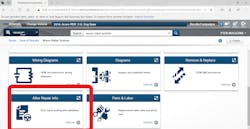Tools Used:
Mitchell 1 Pro Demand
Diagnostic Scan Tool
ADAS Component Alignment Tools
ADAS Target System
One of the latest technologies introduced to vehicles is grouped into a category commonly referred to as Advanced Driver Assistance Systems (ADAS). This technology has the fastest growth in electronics. It is used in vehicles and is primarily used for driver convenience and safety, but is also the primary bridge for making autonomous and “connected car” vehicles possible.
Due to the ability of the system to avoid, or at minimum reduce, the severity of a crash, ADAS is quickly becoming a must-have on late model vehicles. In fact, vehicles in the EU have been mandated to have collision avoidance systems installed on all new vehicles built in 2020, with U.S. car makers following suit in 2022. Additionally, the liability of a collision may eventually shift from the driver to the electronic systems responsible for collision avoidance. This could include potential liability for a technician repairing an ADAS component, or failing to calibrate a system after a seemingly normal repair that caused a sensor to become misaligned.
When it comes to ADAS, it is necessary to fully understand how the systems work and how they interact with other vehicle systems. Additionally, there are other components and systems within the vehicle that may affect ADAS functionality if repairs are done without completing an ADAS calibration.
We will first review the different types of ADAS systems and discuss some of the individual components, then analyze how some repairs can cause a malfunction of ADAS if the repair does not include a recalibration. Please remember this is not a complete list of components, systems, or repairs that are considered ADAS and you must obtain vehicle specific information in order to determine which systems are on any vehicle you are working on.
ADAS Systems:
- Collision Warning
- Collision Avoidance
- Adaptive Cruise Control
- Parking Assistance
- Adaptive Braking
- Lane Departure Warning
- Drowsy Driver Warning
- Pedestrian Detection
- Rear Collision Warning
- Cross Traffic Alert
- Rain Sensor
- Blind Spot Warning
Sensors
Most current ADAS systems use passive sensors to warn the driver of hazards, or use sensors to detect hazards and actively take measures to assist in collision avoidance. The most common passive sensors have been around for many years; the ultrasonic sensors are found in front and rear bumpers on many vehicles. These sensors provide a signal to a module that determines if an object is too close to the vehicle, then the module provides an audible warning to alert the driver. Some of the latest uses of these sensors are to sense obstacles on the side of the vehicle (see image # ?).
Even though these sensors are relatively trouble-free and the most common causes of a failure are from either a damaged or dirty sensor, the steps to diagnose and replace them are fairly simple. On early vehicle models, the sensors may not trigger a fault code, so the only way to test an individual sensor was to cover each sensor and listen for an audible warning from the vehicle. Late model vehicles can set a fault code and will require a scan tool to diagnose. It should be noted that fault codes for these systems can be located in different modules of various vehicles, and it may be necessary to check modules other than the Powertrain Control Module (PCM), or the Body Control Module (BCM).
Other tools required for service include hand tools for sensor removal and pliers for wire stripping and connector repair. Care should be taken when replacing sensors that the correct part replacement is used, and that the installation angle remains unchanged in order to retain original functionality. In some cases a sensor will need to be painted to match the vehicle. If so, use only the matching factory color on the sensor as even the slightest color change may affect the sensitivity of the sensor.
Ultrasonic sensor limitations include being unable to detect objects at long distances and their inability to determine what an object is.
Cameras
The use of cameras provides the system the ability to identify objects while extending the distance for the detection of possible hazards. The use of a camera also allows the system to recognize road signs and pedestrians. Recognizing road signs and pedestrians is critical information necessary for the system to recognize hazards and to react actively. Sign recognition can alert the system when the vehicle is approaching a turn, or even a construction zone, and alert the driver if there has not been a reduction in speed or a steering input necessary for the turn. The down side of cameras is they do not function as well in poor weather and they do not have the ability to determine distance. Because of this, most vehicle makers are using either a camera and a series of ultrasonic sensors, or a combination of cameras, sensors and LIDAR (Light Detection and Ranging) radar units which incorporate the ability to gauge distance, even in poor visibility.
Some systems use these inputs to initiate an active response from the ADAS system. Some active responses from the system include throttle control, braking, steering control, and pre-tensioning of occupant restraint systems.
Cameras can be mounted inside the front windshield and need little to no maintenance. Failures do occur though, and many of them are caused by excessive heat. Because the cameras are mounted very close to the windshield, and the camera itself generates heat, lack of airflow across the camera can sometimes cause an issue. If the camera senses too much heat, they will typically shut off and send a warning to the driver information center that the system is unavailable. Some systems will change the inside temperature of the vehicle in an attempt to reduce the temperature.
Many car makers are now locating cameras in locations other than just the windshield. Rear facing cameras are typically located in the center of the vehicle near the rear license plate. These cameras have now incorporated technology for object detection, along with providing a rear view to a monitor within the vehicle. These camera systems are typically used for object detection, but may be used for other functions such as self-parking.
Many other vehicle manufacturers are placing cameras in the side or in the exterior mirrors of the vehicle. These are used for blind spot and side collision detection. Many vehicles now include forward facing cameras that are mounted in the grille area. Recent additions to camera technology include 360⁰ view cameras that reduce the need for multiple cameras on a vehicle.
In order to diagnose camera issues, the use of a scan tool and access to vehicle specific information will be necessary. First, use vehicle specific information along with your scan tool to identify what, if any, ADAS system components are used on your vehicle. If any faults codes are found, use the vehicle specific diagnostic procedure to correct the issue.
Mitchell 1 ProDemand recently released an ADAS Quick Reference button on their Quick Reference Ribbon at the top of the repair page. This section will allow the technician to quickly obtain information on which ADAS systems are installed on the vehicle they are working on. Not only does the information address which system could be installed on the vehicle, it informs on what types of repairs would necessitate a calibration of each ADAS system, along with the procedure and specific tool or target requirements. Mitchell 1 has done an exceptional job of obtaining and placing this information in an easy to find and understand format. Place Image #? Here, Mitchell ADAS button screenshot)
Common issues include fault “U” fault code module communication failures, dirty camera lenses and mis-alignment of the camera. Technician induced issues include replacing the windshield with glass that is not consistent with the OE requirements of clarity or even the angle of the glass, which can distort the camera’s image. The most common issue, and possibly the worst, is camera mis-alignment. Even some seemingly simple tasks such as replacing a headlamp or a radiator can affect the alignment of a camera or module.
You must keep in mind that the camera provides an image to its module, which uses the image to determine if a potential hazard exists. If the image is distorted, or even more common, the image is not reporting the location of the hazard in the correct relationship to the position of the vehicle, the module will not be able to correctly determine if a hazard really exists. A camera that has been moved as little as a degree or two from its calibrated position can change the reported position of obstacles by as much as 20 feet closer or further from the vehicle.
In order to assure each component is reporting potential hazards correctly, calibrating components to the position of the vehicle is necessary.
Repairs that will likely require an ADAS calibration:
· Glass replacement
· Interior or exterior mirror removal or replacement
· Thrust alignment
· Steering angle reset
· Suspension modifications
· Any repair affecting ride height, including tire or wheel size changes
· Removal or repositioning of any sensor, camera, radar, or LIDAR unit
It is essential to recognize ADAS components while repairing vehicle systems and take care to position them correctly and calibrate them after any repair.
Because these systems are relatively new, some vehicles have required software updates (reprogramming) in some of their modules, which may also necessitate performing a calibration of the sensor or camera.
Aligning or calibrating cameras, radars, or LIDAR systems is vehicle specific, although the steps prior to preparing most vehicles for calibration are similar.
Calibration Preparation Steps:
· Assure tires are inflated to specification
· Ensure fuel tank is full
· All windows, sensors and cameras are clean
· Remove extra cargo from passenger and trunk
· Ensure suspension or tires have not been modified
Some vehicles utilize a dynamic test only to calibrate the camera to the position of the vehicle. A dynamic test starts with assuring the mountings are secure for the imaging device, and that the vehicle’ s electrical system is fully charged and has no issues. Use vehicle specific information to enable the system to start a dynamic calibration. This is typically accomplished by using your scan tool to place the system in a calibration mode, driving the vehicle on a clearly marked highway, and driving it at a specific speed and time determined by the vehicle manufacturer.
Some issues that can prevent a calibration from completing include lanes that are not clearly marked, heavy traffic, rain, snow or fog, or even Botts Dots type of lane markings instead of traditional painted lines. Excess window tint or driving into the sun may also affect the ability to perform a calibration.
Other vehicles use a static calibration for calibrating their systems. In order to perform a static calibration, prepare the vehicle according to the vehicle manufacturer’s specific instructions found in your information source.
The sensors must be aligned both vertically and horizontally to the vehicle’s centerline. Most static calibrations also require specific tools or targets designed to assure that cameras, LIDARs, or other sensors are installed and aligned correctly to the centerline of the vehicle.
Some of the tools required include levels, bubble gauges, laser pointers, and targets with stands. In some cases, specific brackets to attach the tool to a sensor will be required. Target systems utilized for static calibrations are vehicle specific and are required to be placed at specific locations, distances and heights from the vehicle. Many static calibrations will also require a dynamic calibration in order to complete the process.
Other requirements for performing static calibrations are a level bay, clear access around the vehicle, and good lighting with no direct sunlight.
In conclusion, since ADAS is here to stay and as this technology develops, the requirement to repair and calibrate those systems correctly will only become more critical. Taking time prior to any repair to use your information sources to determine if any ADAS system will be affected by the service. Ensuring you have the tools required to calibrate the system after any repair will not only be essential, but profitable.
Historically as automotive technology advanced, repair procedures also required change. With ADAS becoming more common, not only will we be required to check for TSB’s before any repair, using specific vehicle information to determine what ADAS systems are installed and how they could be affected by working on the vehicle is now necessary.



